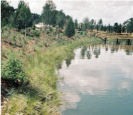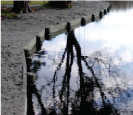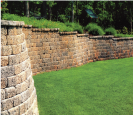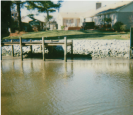Living Shorelines & Wetlands
Living Shorelines are primarily plants that are planted at the waters edge to help with erosion control. Coir logs and ACBs help with erosion control until the plants take root.
Wetlands are plants that are planted in the water that aid in the reduction of pollutants going into the water.
Coir Logs
Coir fiber logs are used for stream and wetland restoration and consist of tightly bound cylinders of coir fibers (Coconut Fiber) that are held together by a coir fiber netting made from coir twine. They are generally between 10 to 20 foot in length and are 12 to 20 inches in diameter. They are excellent to use as a toe protection in areas of low velocity water flow. After installation, the coir fiber log become saturated with water and vegetation can be planted directly on the logs. Coir fiber logs are eco-friendly; they provide a natural appearance and decompose over a three to five year period by which time the plants establish their root into the bank helping to stabilize erosion.
Coir rolls are installed by making a shallow trench along the toe of the streambank. The coir rolls are placed in the trench so that the bottom and back are together with the streambank. They are secured at the toe of the slope using wooden stakes along both sides. Nylon or coir twine is used to secure the coir logs around the wooden stakes and the stakes are driven down firmly, securing the coir fiber roll to the streambed.


Articulated Concrete Block (ACB's)
These uniquely crafted concrete blocks allow natural plantlife growth to occur up, and through the interlocking block system which can be a great solution all around for tidal shores. Perfect for areas with some exposure to waves, these articulated concrete blocks help pack and hold the ground, preventing erosion all while allowing the natural environment to flourish around it, through it, and over it, making the area look nice and natural without the appearance of a bunch of concrete.






